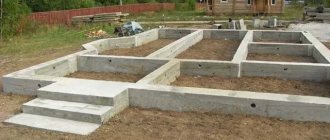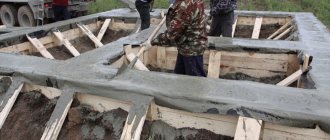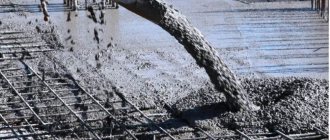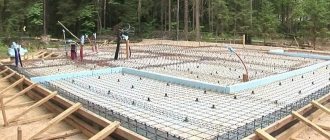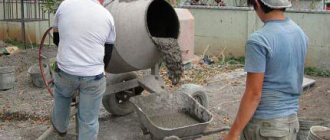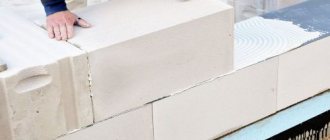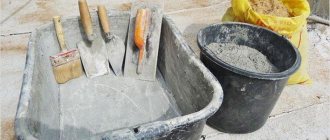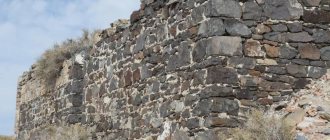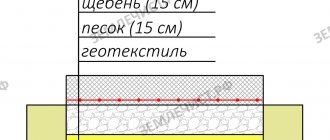Winter construction is quite a complicated matter and not always justified. Frosts, snowfalls, inconveniences and even the impossibility of carrying out certain types of work force many to wait until summer. However, some activities can be carried out in winter, the main thing is to work in relatively warm (not lower than 5...7 degrees below zero) weather and follow the rules. These activities include pouring the foundation in winter.
How concrete gains strength
Concrete is an artificial stone. It consists of crushed stone, sand, cement, water and special additives. Crushed stone and sand provide strength, while cement and water form the “glue” that forms the monolith. Special additives make it possible to give concrete the necessary characteristics: rapid strength gain, the ability to lay in winter, frost resistance, and so on.
Concrete gains strength gradually; this process consists of two stages.
Grasping
– this is a loss of mobility of the solution. Its speed depends on the air temperature. For example, if it is +5 °C outside, the concrete will set in 15–20 hours, but the reference, or design, temperature is considered to be +20 °C. With it, setting occurs 1–3 hours after mixing the concrete mixture, that is, mixing all components with water. Before setting begins, you need to have time to place the mixture in the formwork, compact and level it.
Strengthening, or hardening
is the process of achieving a given strength by a concrete mixture. The optimal conditions for its collection are a temperature of +20 °C and a humidity level of 80%. The estimated period of “hardening” to brand strength at normal temperature and without additional measures is 28 days. Then the strength gain of concrete slows down, but does not stop growing throughout its entire service life.
Brand strength is an important characteristic of concrete. It is designated by the letter “M” and numbers from 50 to 1000 - the higher the index, the stronger the concrete. Physical and mechanical characteristics are determined by the selection of the composition of the concrete mixture, its water-cement ratio, as well as the quality of the components used: fillers, cement, water and additives.
Selection of composition
For winter concrete, the components are prepared more carefully than for concrete that gains strength under normal conditions. Recommended:
- use quick-hardening cement, Portland slag cement or ordinary PC grade M400 and higher;
- antifreeze additives should be combined with plasticizers;
- do not use PMD in mixtures with pozzolanic or aluminous cement;
- prevent inclusion of snow and ice in aggregates;
- prescribe the amount of antifreeze additives taking into account the air temperature;
- reduce the water-cement ratio to the minimum possible.
Sodium nitrite and nitrate in liquid or crystalline form, as well as nitrodap and lignosulfonates are used as PMD. But they cannot be used in concrete with alumina binder and at high, variable groundwater levels.
Why increase the water resistance of concrete?
The higher the water resistance of concrete, the less susceptible it is to water pressure, as well as the effects of chemically aggressive substances in the soil and groundwater: acids, alkalis, salts, and so on. The water permeability of concrete is negatively affected by excess mixing water, undercompaction of the concrete mixture and lack of maintenance of freshly laid concrete.
Water that has not entered into the hydration of cement (the so-called transformation of a plastic mass into a monolith) forms pores in the concrete after evaporation. Some of them are not closed and form end-to-end channels. Moisture penetrates through them into the foundation, which expands when freezing, which contributes to the further destruction of concrete.
To reduce the amount of mixing water while maintaining the mobility of the concrete mixture, plasticizers are used. They reduce the water-cement ratio, reduce the pore volume in concrete and increase its density. It should be taken into account that it is necessary to select the composition of a specific concrete mixture in laboratories, taking into account the features and characteristics of the materials used: cement, coarse and fine aggregates and various additives.
During installation, special attention is paid to compacting the concrete. The concrete mixture must completely fill the required space without creating voids. This is especially important with dense reinforcement of the structure. For these purposes, special devices are used - deep and surface vibrators.
Preheating components
All components of concrete except cement are heated to a certain temperature before mixing:
- fillers - up to 55-60°C;
- water - up to 90°C.
It is forbidden to heat cement, as it may lose activity. First, hot water is poured into the concrete mixer, and after several revolutions, aggregates are added. Cement is placed into the already cooled mixture. The temperature of the finished concrete before pouring should not be lower than 35°C.
The warm mixture is placed in the formwork. While it cools, the cement hydration reaction begins in the solution. Additional heat kickstarts primary hardening, maintaining the temperature of the concrete at the desired level.
How to care for concrete after pouring
In concrete with a low water-cement ratio, it is necessary to retain water, which is needed for the hydration process. If this is neglected, the quality of the final product will noticeably decrease. The standard concrete care regimen involves moistening the freshly laid foundation every 3-4 hours for the first 3-5 days after pouring, depending on the ambient temperature. Also, the concreting area is covered with damp burlap or film, and special film-forming compounds are used.
Preparation of concrete mixture
When arranging the foundation, the question often arises: “Is it possible to pour a foundation in winter using ordinary concrete?” No you can not.
For these purposes, one that contains special modifiers is suitable. Thanks to additives, concrete has time to gain the necessary qualities; it does not set prematurely. In addition, modifying additives make it much easier to pour concrete into the formwork.
When choosing modifiers, you should pay attention to frost resistance indicators and the rate of hardening of concrete. The required amount of the substance is determined according to the scale indicated on the packaging.
What are penetrating additives
To increase the water resistance grade of concrete, mineral materials of penetrating or penetrating action are often used. They are added to the mixture during preparation or applied to a prepared surface, that is, cleaned of dirt and cement laitance, as well as a water-saturated surface using a plaster sprayer or brush.
Active chemical additives in the material react with the components of the concrete mixture. As a result, insoluble compounds or crystals are formed. They create a continuous barrier that prevents the flow of water. Depending on the type of concrete being processed, the degree of its waterproofness can be increased by two or three levels.
Warming up the pit
The hydration reaction is possible at temperatures above +5°C. Therefore, cooling of the concrete mixture below this indicator should not be allowed.
Preparation for installation begins with heating the pit. In the conditions of individual private construction, open-flame fires, reflector stoves, thermomats, hot coolants - sand, slag - are used.
The hardest thing is to prepare the foundation pit for the slab foundation. A large area of soil heats up slowly and cools down quickly. But it is much easier to warm the trenches under the strip base. The route can be prepared not entirely, but in parts, and monolithic work can also be carried out in separate sections.
What to look for when concreting a foundation
In order to competently carry out construction work and reduce further costs of repair and operation of the foundation to a minimum, you must adhere to a few simple rules:
- The foundation design should not allow cracks to form under any load.
- The entire volume of concrete must be poured without technological and “cold” joints, that is, in one technological cycle.
- If the work involves the formation of technological seams, they must be sealed using swelling cords, sealants or waterstops.
- Working reinforcement must be installed in strict accordance with the design; the thickness of the protective layer of concrete must be at least 15 mm.
- It is necessary to compact the laid concrete with vibrators or use self-compacting concrete.
- Newly laid concrete needs to be maintained.
What time of year is best to pour the foundation?
Difficult weather conditions negatively affect the strength gain of concrete.
Abundance of precipitation
at the stage of setting the concrete mixture can lead to its saturation with excess moisture. This leads to an increase in the water-cement ratio and a decrease in the strength of concrete.
Frost
turn mixing water into ice, which disrupts the hydration process of cement. When water freezes, it expands and internal stresses arise in the freshly laid concrete, which leads to damage to the foundation.
High air temperature, low humidity and wind
increase the rate of water evaporation from freshly laid concrete. This leads to disruption of the process of cement hydration and destruction of concrete in the surface layer, the appearance of shrinkage cracks.
Based on this, and also taking into account that the process of concrete gaining strength lasts 28 days, the optimal time for pouring the foundation is the period from late spring to early summer.
In addition to the advantage of comfortable conditions for carrying out work, there will be enough time ahead to eliminate possible defects, arrange waterproofing and additional protection. As a result, a foundation built in the spring will not be afraid of autumn temperature changes and winter frosts.
Possible options for filling at negative temperatures
When pouring a foundation in winter, only one mode of ebb of a concrete monolith is recommended - the entire volume is immediately poured out and used. This is an architectural rule that cannot be violated.
But in some cases, layer-by-layer ebb is possible. In particular, when laying a monolithic slab with a shallow entry into the ground. Such foundations are used for small-sized structures with low weight. The excavation is also made, provided with an insulating layer, formwork is erected, but the concrete is supplied layer by layer in compliance with the technology:
- A height of 10 centimeters of thick concrete is poured to the base.
- In the middle there is lightweight concrete no higher than 10 centimeters.
- After they have partially hardened, thick concrete is poured onto the top to the final height.
Layer-by-layer casting of concrete of one fraction will lead to delamination, but different densities will allow the foundation to “get tied” and become a monolith.
How to pour a foundation in winter
If it is still necessary to concrete the foundation in winter, several technological methods are used.
Antifreeze additives and hardening accelerators
– they allow work to be carried out at sub-zero temperatures without loss of speed and quality.
Heating concrete with an electric cable
– it is attached to the reinforcement frame and connected to the network, and then remains in the body of the concrete.
Warming up concrete with heat mats
– unlike cables, mats are installed on the surface of a heated structure and can be used repeatedly.
Arrangement of the greenhouse
− this is a structure similar to a greenhouse, which is assembled above the work site. Heat guns are installed inside to maintain positive temperatures, so in the “warmhouse” you can safely carry out foundation construction work: knitting the reinforcement frame, concreting, installing waterproofing and installing waterstops.
Possible consequences
The negative consequences of winter construction of foundations are primarily associated with violations of technology:
- The concrete will begin to crumble and fall off in pieces if the moisture is not evaporated from it by additional heating.
- Concrete will sag if there is no preparatory work for the soil and if the nature of the soil is not analyzed.
- When moisture freezes, the volume will increase, which will lead to deformation of the sides of the foundation and squeezing out the soil.
In addition, when constructing monolithic structures made of concrete - “concrete boxes”, wet concrete will negatively affect the health of those in the room.
Ultimately, all the consequences can be described as unsatisfactory quality of the foundation, which is a precedent for rejecting the entire building and banning its operation. But, if you approach the issue scrupulously and use all the recommendations in this article, you can quickly and efficiently build the foundation of a future structure in any frost.
Bottom line
The optimal time for pouring the foundation in most regions of Russia, except the northern ones, is the second half of spring or early summer. During this period, the optimal weather for concreting work is established. Here are the main points to pay attention to when conducting them:
- Entrust the work of decoupling the reinforcement frame and concreting to a specialized organization. This way you will avoid mistakes, the correction of which can be very expensive.
- Use only ready-mixed concrete of appropriate strength and water resistance grades. Methods of preparing concrete on site in a metal bath and using shovels are strictly unacceptable.
- Carry out concrete work without forming cold joints.
- Increase the water resistance of concrete using special additives. For example, penetrating.
- Freshly laid concrete needs to be maintained. Cover it with damp burlap and water it every two or three hours, even at night, for 3 to 5 days. If the weather is hot, it is better to water within 7 days.
- Carry out foundation work in winter using special methods.
- If possible, check the thickness of the concrete cover using a rebar locator. It must be at least 15 mm.
- Additionally, protect foundation structures from the negative effects of soil and groundwater.
Negative sides
Pouring the foundation of a house in winter is allowed. But there are negative points:
- savings on building materials are undeniable. But the price of excavation services is significantly higher. Additional expenses will be spent on warming up the concrete solution and maintaining the temperature during the first days of hardening. When weighed, the savings are questionable;
- the efficiency of the labor process is lower in winter compared to summer. It is more difficult for workers to perform the same type of work due to deteriorating working conditions;
- the cost of additives and modifying components is low. If a large foundation is to be poured, a lot of material will be required. Costs will increase significantly;
- Construction machinery and equipment required. It will not be possible to dig a high-quality pit by hand. Especially if the base is large.
